The Gatehouse weatherstation is located in the hamlet of Gatehouse in Tarset, Northumberland, England at:
- 55°11'40" North
- 2°20'4" West
- 173 m elevation above sea level.
The original 2010 mounting location of the external weatherstation has been changed once. Due to growth of nearby trees, the weatherstation was relocated from a ground-mounted tripod to a wall-mounted bracket on a gable wall in June 2022. The elevation is unchanged due to ground-level differences. Rainfall measurements are now more accurate than the original location which had some rain shading due to a tree, but wind direction data are probably less reliable due to the closer proximity to two buildings.
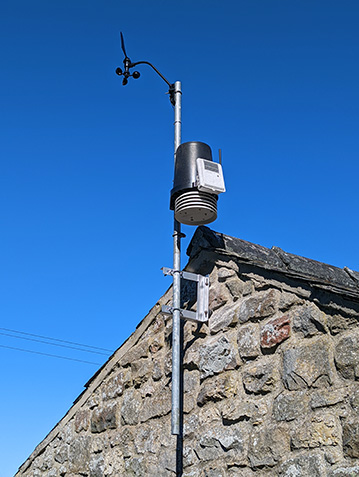
The Gatehouse weatherstation provides live weather data for Gatehouse in Tarset, near the popular tourist areas of Kielder Forest, Kielder Water and English Heritage's Black Middens Bastle House. Gatehouse itself is within both the Northumberland National Park, and the Northumberland Dark Sky Park, Europe’s largest area of protected night sky.
Conditions and forecasts
The weatherstation provides a very short-term forecast based on the current conditions and pressure trend. Alternative medium and longer-range forecasts are available for:
- Tarset Burn, from the Norwegian Meteorological Institute with European Weather Centre data
- North East England, from the UK's MetOffice
Current conditions in Tarset and further afield can also been displayed using the live visualisation tool Ventusky published by InMeteo.
Equipment
The main system components currently are:
- Davis Vantage Pro II wireless weather station
- Meteobridge Pro2 wireless data receiver/logger
- Raspberry Pi Zero 2W with High Quality Camera and manual lens
- This website hosting the database archive and public display of information.
From 2017 a manual rain gauge has been used to complement data from the automatic weather station. The device is a 5-inch standard cylindrical rain gauge comprising a funnel with a sharp rim, with a storage bottle inside a storage vessel. Precipitation is determined by measuring the accumulated water in the storage bottle using a specially calibrated translucent plastic measuring cup. Snowfall can also be measured by melting the snow with a known volume of hot water. The manual gauge has been positioned nearby the automatic station. Measurements are being taken weekly, compared with the readings from the automated (tipping bucket) rain gauge, and the stored data records are adjusted if necessary.
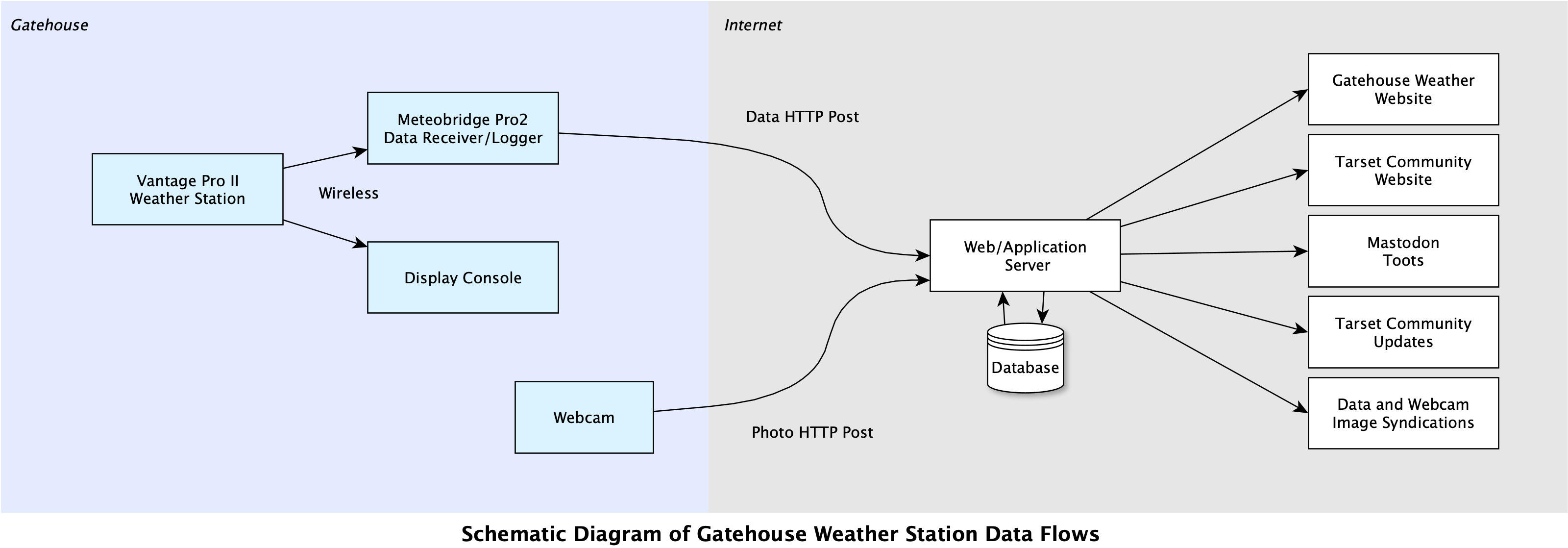
The Davis Vantage Pro II was purchased from Cambridgeshire-based Prodata Weather Systems. Originally when the weather station was set up in 2008, commercial software running on a Windows XP PC was used to communicate with the local weather station data logger, which in turn polled information from the external weather station wirelessly. The internal PC aggregated the information and emailed weather data to the remotely hosted web server every 10 minutes. But the PC was over-powered for these basic requirements and, having to run 24 hours/day, lead to un-necessary energy usage. In May 2015 the personal computer (PC) at Gatehouse Cottage and the web server that publishes the information were completely replaced with a credit-card sized Pi computer from the Raspberry Pi Foundation, running WeeWX software to process information from the Davis data logger connected wirelessly to the Davis Vantage Pro II. In 2023, the Davis data logger and the Raspberry Pi were replaced with a single device, a Meteobridge Pro2, to reduce power usage further, and avoid the need to maintain additional software.

A Y-Cam White netcamera was used initially for webcam images, but this was replaced in late 2024 after 16 years. Many current webcams are aimed at the security or wildlife markets, coming with infra-red LEDs, motion detection, auto-focus and often inherently linked to proprietary cloud storage services. None of those are desirable for a constant scene day and night, nor provide methods to send images directly to a different system. Therfore a competitively-priced very low-power small Raspberry Pi computer board (Pi Zero 2W) with a HQ Camera and separate manual lens (photo below) were set up and configured as a replacement. This runs a small computer program every 10 minutes to take a still image and send that to the Tarset Weather website where the latest image and hourlies for the current day can be viewed. This new camera can take higher-resolution photos and provides greater control over the exposure settings and post-capture adjustments.
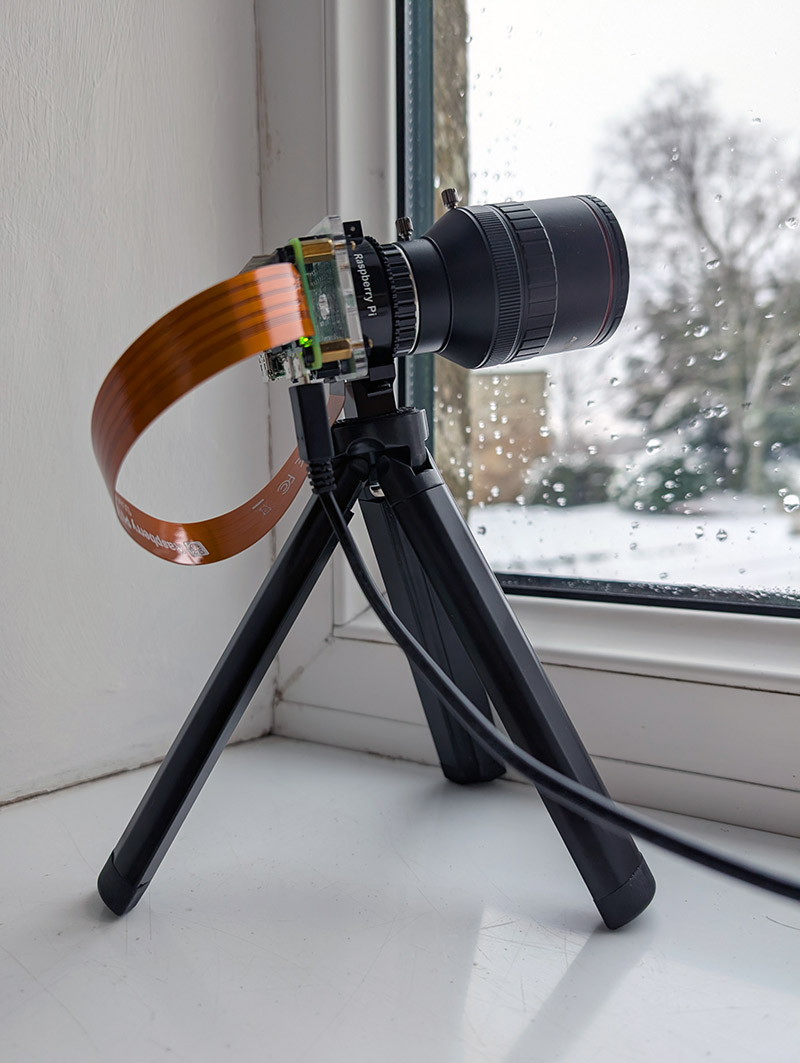
Website
The Davis Vantage Pro II weather station began operation in August 2008. Excluding some network outages and sensor faults, it has been collecting weather data continuously. When it was first commissioned there were very few choices available for exporting and republishing the data. All the free and commercial weather display software were rather clunky and poorly designed. Initially weather data was emailed to a web server hosting the Gatehouse Cottage website, where the data were stored in a MySQL database and an XML summary file published. This XML was used by two specially written Adobe Flash applications — the primary weather information display on the Gatehouse Cottage website and a summary weather panel on the Tarset website.
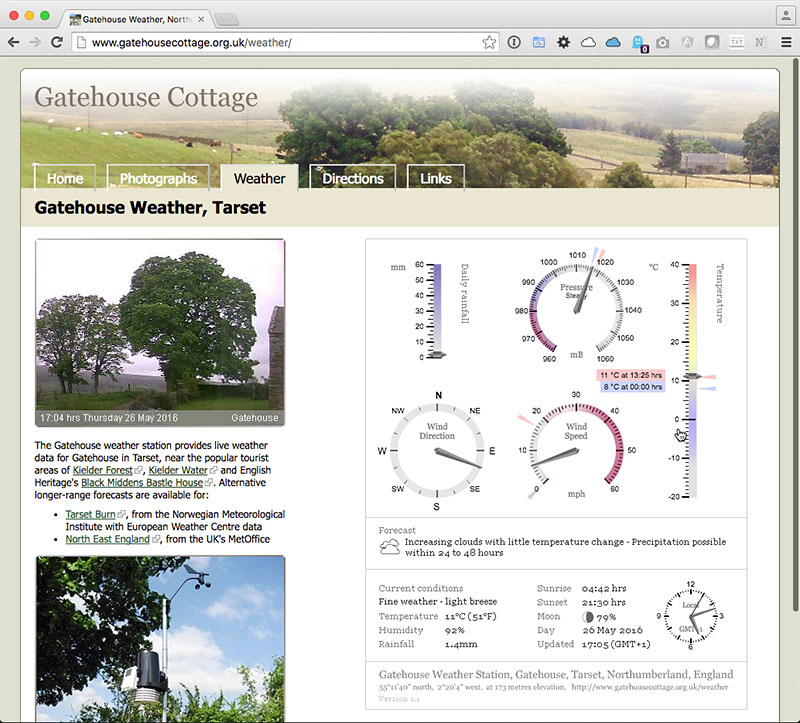
When the Tarset website's design was refreshed in March 2015, the home page weather panel was changed to make it compatible with a wider range of user devices, including mobile phones and tablets.
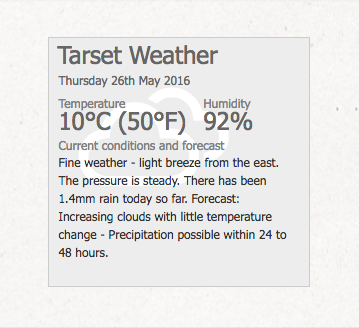
In May 2016 the previous Adobe Flash weather display information was replaced this new custom-created HTML5/JavaScript version for better cross-browser and mobile device support, using a responsive mobile-first design. In June 2022, the temperature gauges and charts were updated to take into account the new maximum daily temperature value of 35.4°C recorded on 19 July 2022. Temperature data display was also changed from zero to one decimal place, to reflect increased confidence in the accuracy and precision of the weatherstation's temperature sensor.
Tarset Community
Since 2008, updates or weather charts and summary data have been provided to the quarterly local newsletter Tarset News/Diary or to the Tarset Community Mailing List.
Mastodon
The weatherstation first tweeted in 2010. But since January 2023, the weatherstation toots regularly on Mastodon. Initially this used the @botsin.space server, but now using @[email protected]. Each day this comprises a summary of the previous day's conditions at 05:00hrs, current conditions at 06:00, 12:00, 10:00 and 23:00hrs, with the forecast at 07:00hrs and hourly if it changes.
Weather Observation Website
Data from the weather station are published to the Royal Meteorological Institute of Belgium's Weather Observation Website public repository (and before that, the now abandoned MetOffice WOW).